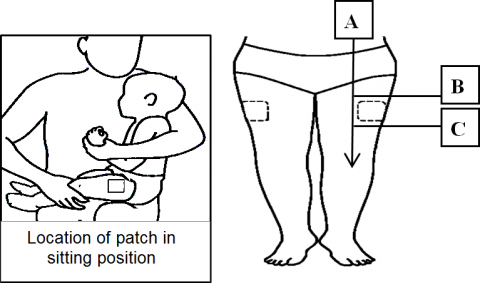Immunizations protect against serious diseases, however they can also cause discomfort. One way to reduce the discomfort from immunizations is to use topical anesthetics, also known as numbing creams or patches.
The information in this HealthLinkBC File shows you where to put numbing creams and patches for infants, toddlers, and older children for routine immunizations. If you have questions about where your child's immunizations will be given, talk to your immunization provider prior to your visit. For a full list of ways to reduce your child’s discomfort during immunization, see HealthLinkBC File #50e A Better Immunization Experience for your Child.
What are numbing creams and patches?
Numbing creams or patches ease the feeling of pain by blocking pain receptors in the skin. Numbing creams and patches can be purchased from your local pharmacy. You do not need a prescription from your health care provider to buy them.
How do I use numbing creams and patches?
There are multiple products available and these may have different instructions for how they should be used. Use of these products will change depending on:
- the age of the child;
- how the product is applied;
- the amount of product to be used;
- the length of time the product needs to be applied; and
- how long the product lasts once it is removed.
It is important to read and follow the package instructions carefully before using these products on your child.
Creams or patches need to be applied prior to the immunization visit because the product needs time to numb the skin once it is applied. The time needed to numb the skin may vary from 30 to 60 minutes after it is applied. Be sure to follow the product instructions.
If you remove the product before your appointment, outline the edges of the patch or bandage covering the cream with a pen. This will show your health care provider where the numbing cream or patch was applied.
The instructions below are for children who are being immunized according to the B.C. routine childhood immunization schedule. For more information, see the B.C. Immunization Schedules.
Where do I apply numbing products for the 2, 4 and 6 month immunization visits?
At these visits, immunizations are given in the upper leg (thigh). Numbing creams or patches need to be applied to the positions shown below.

Follow these steps when applying the numbing cream or patch:
- Lay your child down facing you.
- Draw an imaginary line down the middle of the front of one of your child’s legs, from the hip to the knee (line A).
- Next divide the upper leg into 3 equal sections (lines B & C). Apply the cream or patch to the middle outer section of the leg.
Repeat steps 2 and 3 on your baby’s other leg for the 2 and 4 month immunization visits.
| Age | Where to put cream or patch |
|---|---|
| 2 months | Apply to both legs as shown. |
| 4 months | Apply to both legs as shown |
| 6 months | Apply to 1 leg as shown |
Where do I apply numbing products for the 12 and 18 month immunization visits?
At these visits, immunizations are given in the upper arm to the positions shown below.

Follow these steps when applying the numbing cream or patch:
Upper arm
- Have your child sit with their sleeve rolled up and their upper arm facing you.
- Place the patch or dose of cream in the top section on the side of the arm (A).
For the 12 month visit, do this again on the other arm.
Back of the arm
- Have your child sit with their sleeve rolled up and their arm facing you.
- Put the patch or cream in the middle section on the back of your child’s arm (B), half way between their shoulder and elbow. For the 12 month visit, do this again on the other arm.
| Age | Where to put cream or patch |
|---|---|
| 12 months | Apply to the top section on the side of the arm and back of both arms as shown. (A & B to both arms) |
| 18 months | Apply to top section on the side of one arm only. (A to one arm only) |
Where do I apply numbing products for the 4 to 6 year immunization visit?
The immunizations given at 4 to 6 years of age are given in the upper arm. The numbing cream or patch should be applied to the upper arm as shown for children at the 12 month immunization visit.
| Age | Where to put cream or patch |
|---|---|
| 4 to 6 years | Apply to the top section on the side of the arm and also to the back of one arm only (A & B to one arm only) |
Numbing creams can also be used in older children and adults.
How do I safely use numbing products and are there side effects?
Prior to use, read the product instructions and be sure numbing creams or patches are safe to use on your child. Be sure that you do not use more than the recommended amount of numbing product for your child’s age. Side effects are generally minor, limited to local skin reactions where numbing creams have been applied. These include paleness, redness or swelling of the skin. Serious side effects occur rarely. In the event of these or any other reaction, the product should be removed immediately and you should contact your health care provider for advice.
Watch your child closely once the cream or patch has been applied. Bandages and patches can be a choking hazard if your child pulls them off. Put clothing over the area to prevent this.